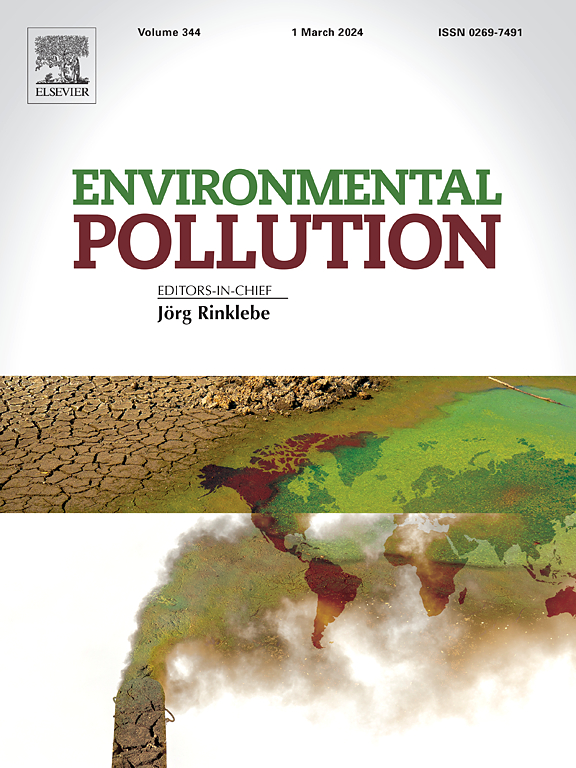Exploring the distribution and transmission mechanism of ARGs in crab aquaculture ponds and ditches using metagenomics
IF 7.6
2区 环境科学与生态学
Q1 ENVIRONMENTAL SCIENCES
引用次数: 0
Abstract
Aquaculture provides notable economic benefits; however, the excessive use of antibiotics has resulted in the production and spread of antibiotic resistance genes (ARGs). The intricate pollution dynamics in aquaculture areas complicate the comprehension of the distribution and transmission of ARGs in aquaculture systems. Using metagenomic sequencing technology, this study used eight ponds and four ditches in a large crab aquaculture area in Taizhou City, where Proteobacteria (61.58%) and Acidobacteria (6.04%) were identified as the dominant phyla and Thiobacillus (1.84%) and Lysobacter (0.99%) were the dominant genera. Network and linear discriminant analysis effect size (LEfse) analyses showed that Proteobacteria and Lysobacter were the main host phyla of ARGs, and Lysobacter, which are key host bacteria in ponds, played an important role in determining the abundance of ARGs in ponds. Co-occurrence network analysis (spearman r>0.7, p<0.01) revealed that prophages can dominate the spread of ARGs by carrying several ARG subtypes (rsmA, OXA-21, THIN-B and lnuF). Analysis of variance demonstrated that functions related to the horizontal gene transfer (HGT) of ARGs, such as EPS synthesis (lptF), oxidative stress (gor and ompR), ATP synthesis (lapB and vcaM), and cell membrane permeability (yajC and gspJ), were significantly expressed in the pond (p<0.05), confirming that ARGs had stronger transmission potential in the pond. The Mantel test and partial least squares path modeling (PLS-PM) analysis showed that ARGs exist in bacteria and spread among them through mobile genetic elements and HGT. This study revealed the distribution and transmission mechanism of ARGs in the ponds and ditches of a crab aquaculture system and provided a theoretical basis for controlling the spread of ARGs in crab aquaculture in this area.

水产养殖带来了显著的经济效益;然而,抗生素的过度使用导致了抗生素耐药基因(ARGs)的产生和传播。水产养殖区错综复杂的污染动态使人们难以理解 ARGs 在水产养殖系统中的分布和传播。本研究利用元基因组测序技术,对台州市某大型河蟹养殖区的8个池塘和4条沟渠进行了研究,结果表明蛋白细菌(61.58%)和酸性细菌(6.04%)为优势菌门,硫杆菌(1.84%)和溶菌酶(0.99%)为优势菌属。网络和线性判别分析效应大小(LEfse)分析表明,变形菌和溶菌是ARGs的主要宿主菌门,而溶菌是池塘中的关键宿主菌,对决定池塘中ARGs的丰度起着重要作用。共现网络分析(spearman r>0.7,p<0.01)显示,噬菌体可通过携带几种ARG亚型(rsmA、OXA-21、THIN-B和lnuF)主导ARGs的传播。方差分析表明,与 ARGs 水平基因转移(HGT)相关的功能,如 EPS 合成(lptF)、氧化应激(gor 和 ompR)、ATP 合成(lapB 和 vcaM)和细胞膜通透性(yajC 和 gspJ),在池塘中均有显著表达(p<0.05),证实 ARGs 在池塘中具有更强的传播潜力。Mantel检验和偏最小二乘路径模型(PLS-PM)分析表明,ARGs存在于细菌中,并通过移动遗传因子和HGT在细菌中传播。该研究揭示了ARGs在河蟹养殖系统池塘和沟渠中的分布和传播机制,为控制ARGs在该地区河蟹养殖中的传播提供了理论依据。
本文章由计算机程序翻译,如有差异,请以英文原文为准。
求助全文
约1分钟内获得全文
求助全文
来源期刊

Environmental Pollution
环境科学-环境科学
CiteScore
16.00
自引率
6.70%
发文量
2082
审稿时长
2.9 months
期刊介绍:
Environmental Pollution is an international peer-reviewed journal that publishes high-quality research papers and review articles covering all aspects of environmental pollution and its impacts on ecosystems and human health.
Subject areas include, but are not limited to:
• Sources and occurrences of pollutants that are clearly defined and measured in environmental compartments, food and food-related items, and human bodies;
• Interlinks between contaminant exposure and biological, ecological, and human health effects, including those of climate change;
• Contaminants of emerging concerns (including but not limited to antibiotic resistant microorganisms or genes, microplastics/nanoplastics, electronic wastes, light, and noise) and/or their biological, ecological, or human health effects;
• Laboratory and field studies on the remediation/mitigation of environmental pollution via new techniques and with clear links to biological, ecological, or human health effects;
• Modeling of pollution processes, patterns, or trends that is of clear environmental and/or human health interest;
• New techniques that measure and examine environmental occurrences, transport, behavior, and effects of pollutants within the environment or the laboratory, provided that they can be clearly used to address problems within regional or global environmental compartments.
 求助内容:
求助内容: 应助结果提醒方式:
应助结果提醒方式:


